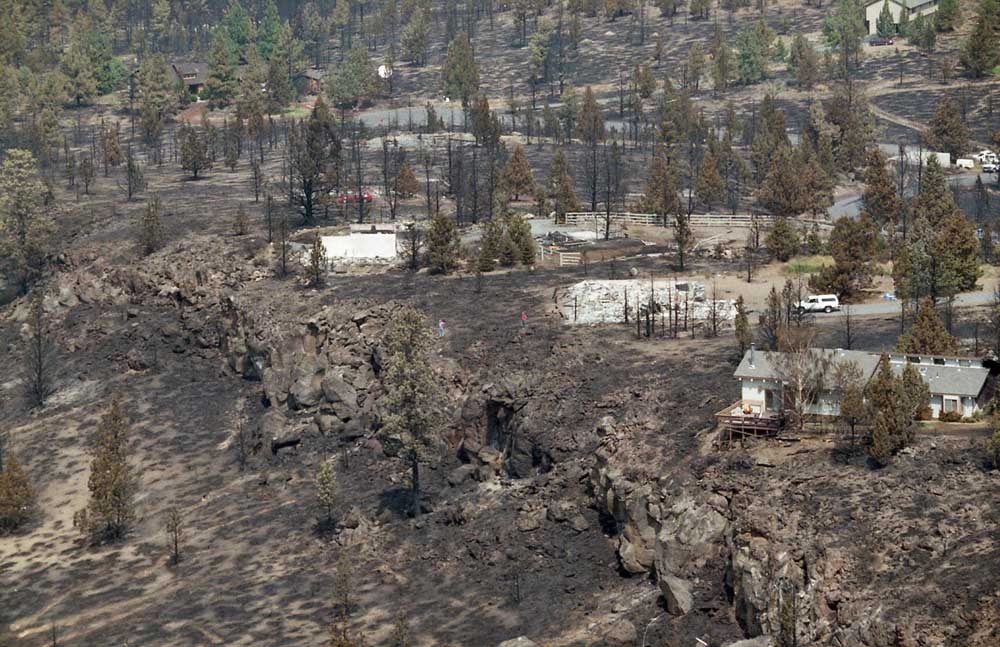25 years later, Skeleton Fire reminds residents of wildfire destruction
Published 5:00 am Sunday, August 22, 2021

- The Skeleton Fire southeast of Bend in August 1996 burned more than 17,700 acres and destroyed 19 homes. The fire helped spur an effort to clear defensible space around homes in fire-prone areas.
Jerry and Claudia Brown are constantly reminded of the Skeleton Fire that tore through their neighborhood southeast of Bend and destroyed their home 25 years ago.
On his daily walks through the Sundance subdivision, Jerry Brown, an 81-year-old retired millwright, can see the empty landscape where a thick forest of trees once stood. His wife often finds pieces of their old house while pulling weeds in a flower bed.
Everything happened so quickly that day. The couple could see the glow of the fire approaching their home as they listened for updates on a police scanner. Then came a knock on the door. A deputy told them they had to leave. They had 15 minutes to grab a few documents, pictures and jewelry.
“It was a fire storm,” Claudia Brown said. “The trees weren’t just catching fire, they exploded. It’s a wonder nobody died.”
The Skeleton Fire started by lightning Aug. 23, 1996. By the next day, wind blew the fire toward the Sundance subdivision, where it destroyed 19 homes and burned more than 17,700 acres.
The event changed the way Deschutes County residents thought about fire safety and led to a movement of homeowners taking steps to protect their homes from wildfires. The year after the fire, county officials launched FireFree, a program that provides education to residents to prepare their homes for the threat of wildfire.
On Monday — the 25th anniversary of the Skeleton Fire — Sundance residents and homeowners across Central Oregon will be reminded of the dangers from wildfires, especially as fires have become more prevalent in recent years.
Sundance residents hope their experience is a lesson for others in the region. For the Browns, it’s changed the way they plan trips when the weather warms up.
“We don’t travel during the summertime,” Jerry Brown said. “It’s still very much on our minds about fire season and what could happen.”
For several years, the Browns and their neighbors didn’t have to worry about wildfire protection after the Skeleton Fire because their neighborhood was still covered in black ash. But now trees and brush have grown back, and with them, a renewed sense of fire danger.
Oliver Tatom, a registered nurse and paramedic who lives up a hill from the Browns, was 17 when his home was leveled by the Skeleton Fire. Tatom, who was recently elected to the Deschutes Rural Fire District Board of Directors, recalls a conversation he had with a Deschutes County Sheriff’s Office sergeant a few years ago about how his neighborhood is again exposed to wildfires.
Tatom realized he had to take action.
“That’s what planted the seed to bring the neighborhood together and see what we could do to make our neighborhood less vulnerable to fire,” Tatom said.
Tatom decided to spearhead an effort this year to get this neighborhood recognized by Firewise USA, a national program that encourages neighbors to work together and take action to prevent damage from wildfires.
With the recognition, the Sundance community qualifies for grants from Deschutes County and can start organizing community cleanup events. The neighborhood is one of 46 Firewise communities in the county.
Sundance residents are also planning to clear out flammable brush along the evacuation routes in the neighborhood, Tatom said.
“That’s not a conversation we would have if we weren’t a Firewise community,” Tatom said.
Gary Marshall, executive director of the Deschutes Rural Fire District, was a Bend Fire & Rescue deputy fire chief and fire marshal at the time of the Skeleton Fire.
Marshall remembers how quickly the winds shifted Aug. 24, 1996 and pushed the fire through the Sundance subdivision. The fire couldn’t be stopped before hitting the neighborhood, Marshall said.
A few days later, Marshall recalls loading the displaced residents onto school buses and showing them their burned home sites.
“It was very emotional,” Marshall said. “It was probably the next thing to losing a loved one. They lost everything.”
After the fire, Marshall was approached by an insurance company that offered to buy a fire engine for the department. Marshall wasn’t interested.
“I said, ‘No that isn’t going to help,’” Marshall said. “What we need to do is change some personal behavior and attitudes of the homeowners.”
Instead, Marshall asked if the insurance company would fund a fire-prevention program. The company agreed, and FireFree was born.
“At that time, there was no other type of program like that,” Marshall said.
In addition to fire prevention, the Skeleton Fire led to a change in how homes are constructed in Central Oregon. Homes in the Sundance community were required to have cedar shake roofs, which are now known to be highly flammable in a fire, Marshall said.
Today, roofs are being built with metal, tile or composition shingles.
“These are the types of efforts Bend and Deschutes County residents have taken with developers to make sure when they do build in these fire prone areas, that they are building safely,” Marshall said.
The Browns were able to move into their new home by New Year’s Day 1997. Rather than wood siding and roofing, their new home was built with a concrete-based siding and composition shingles.
The couple is eager to join the community’s Firewise cleanup efforts, which should start later this fall or early next year. They want to take every precaution to avoid another devastating fire.
The Browns never again want to experience sitting in the school bus with their neighbors as it turned the corner and revealed their house was gone.
“It looked like a moonscape,” Claudia Brown said. “Everything was gray.”






